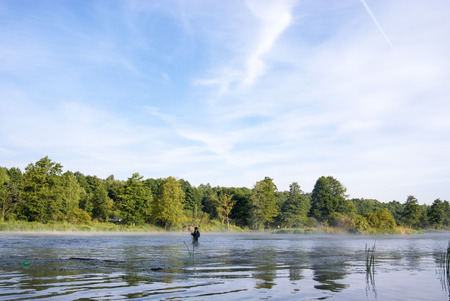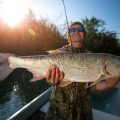Introduction: The British Tradition of Catch and Release
British angling, with its centuries-old roots and storied riverside rituals, is much more than a pursuit for sport or sustenance—it is a proud cultural tradition. From the chalk streams of Hampshire to the wild lochs of Scotland, anglers across the United Kingdom have long cherished the serenity and challenge of fishing. In recent decades, catch and release has risen to prominence as a defining feature of modern British angling culture. Once primarily focused on taking fish home for the table, today’s anglers are increasingly committed to conservation, valuing the health and longevity of native fish populations. This shift reflects both a deep respect for nature and an evolving understanding of sustainable practices. As catch and release becomes woven into the fabric of British fishing, it sparks lively debate and gives rise to persistent myths—misconceptions that deserve careful scrutiny in order to ensure the future vitality of this beloved pastime.
2. Myth: Catch and Release Causes No Harm to Fish
It is a widely held belief among British anglers that catch and release is a completely harmless practice, ensuring the well-being of fish populations across the UK’s rivers, lakes, and lochs. However, while catch and release is undoubtedly preferable to keeping every fish landed, scientific research has shown that it is not entirely without impact.
The Realities Behind the Practice
Studies conducted in British waters have revealed that improper handling or extended time out of water can lead to stress, injury, or even delayed mortality in released fish. For example, trout and grayling—favourites among UK fly fishers—are particularly sensitive to temperature changes and rough handling. Even seemingly minor actions such as dry hands or squeezing can remove the protective slime layer on fish, making them more vulnerable to disease.
Key Factors Affecting Fish Survival Post-Release
| Factor | Impact on Fish | Best Practice for UK Anglers |
|---|---|---|
| Handling Time | Longer air exposure increases stress and mortality rates | Keep fish wet; minimise time out of water (ideally under 10 seconds) |
| Water Temperature | High temperatures reduce oxygen; stress increases significantly | Avoid fishing during heatwaves; use thermometers for river checks |
| Hook Type | Barbed hooks cause more damage than barbless ones | Use barbless or de-barbed hooks to ease removal and reduce injury |
| Lifting Method | Squeezing or dropping can injure organs or scales | Support fish gently with wet hands or a knotless net; never squeeze tightly |
| Photographs | Extended posing increases air exposure and stress | Prepare camera beforehand; keep photos quick and low to the water |
A Culture of Responsibility in British Angling
The UK boasts some of the most passionate angling communities in the world, where conservation and tradition go hand-in-hand. Modern British anglers are increasingly adopting best practice guidelines established by organisations such as the Angling Trust and Wild Trout Trust. These include using appropriate tackle for local species, choosing times of day when water temperatures are lower, and educating newcomers about correct release techniques unique to our native fisheries.
Ultimately, catch and release is only as effective as the care taken by each individual angler. By recognising that this practice carries potential risks—and responding with informed, conscientious handling—we help ensure thriving fish stocks and preserve the unique character of Britain’s waterways for generations to come.
![]()
3. Myth: Catch and Release Has No Conservation Value
It’s a common refrain in some circles that catch and release angling offers little to no benefit for fish populations or their habitats. However, this perception simply doesn’t stand up to scrutiny, especially when we examine the British context. Across the UK, catch and release has become a cornerstone of responsible fishery management—one that’s strongly supported by both scientific evidence and policy outcomes. Take, for example, the River Test and River Itchen in Hampshire, renowned chalk streams where voluntary and mandatory catch and release policies have been instrumental in preserving wild brown trout stocks. Over time, these practices have contributed to healthier fish populations, improved spawning success, and a more balanced aquatic ecosystem. These positive effects aren’t confined to southern England. In Scotland, the Atlantic salmon conservation movement has championed catch and release since the early 2000s, leading to increased survival rates and helping sustain fragile migratory stocks despite mounting environmental pressures.
The impact of these efforts is further strengthened by national strategies. The Environment Agency’s “Catch & Release: Best Practice” guidelines are now widely adopted by clubs and syndicates across England and Wales. These measures are not just box-ticking exercises—they’re based on sound ecological research and have been shown to increase post-release survival rates dramatically when anglers follow recommended handling techniques. The practical results speak volumes: many British rivers now report improved year-on-year recruitment of native species, which benefits not only anglers but also local wildlife and rural economies dependent on healthy waterways.
In short, dismissing catch and release as ineffective ignores both the weight of British conservation successes and the evolving science behind fisheries management. When carried out with care and respect for the fish—hallmarks of traditional British angling—the practice plays an undeniable role in sustaining our treasured rivers for generations to come.
4. Myth: All Species Respond the Same Way
One of the most persistent misconceptions in British angling is that all fish species react identically to catch and release practices. In reality, native species such as Atlantic salmon, coarse fish like barbel or chub, and even game fish such as trout exhibit distinct physiological and behavioural responses when returned to the water. Assuming a one-size-fits-all approach can inadvertently harm both our quarry and our cherished waters.
Species-Specific Reactions
For instance, salmonids (including salmon and trout) are particularly sensitive to handling, temperature changes, and air exposure. Their stress levels post-capture can remain elevated for longer periods compared to robust coarse fish. Meanwhile, species like barbel display remarkable resilience but require careful support during release due to their body structure.
Comparing Responses Among Key British Fish
| Species | Sensitivity to Handling | Recovery Time | Special Considerations |
|---|---|---|---|
| Atlantic Salmon | High | Longer | Minimal air exposure; wet hands recommended |
| Brown Trout | High | Moderate-Longer | Avoid warm water releases; gentle netting essential |
| Barbel (Coarse) | Moderate | Short-Moderate | Support underbelly; revive in current before release |
| Pike (Predatory) | Variable | Short-Moderate | Avoid damage to gills; use unhooking mats |
The Importance of Tailored Practices
This diversity underscores why thoughtful British anglers adapt their approach—choosing suitable tackle, minimising fight time, and using species-appropriate landing nets—to suit the specific needs of each fish. By moving beyond the myth of uniformity, we honour the unique character of our native waters and safeguard their inhabitants for future generations.
5. Modern Angling Ethics and Local Perspectives
The landscape of British angling is in constant flux, and nowhere is this more apparent than in the evolving ethics and attitudes of the community itself. Long gone are the days when riverside camaraderie was solely about the biggest catch; today’s anglers are increasingly defined by their respect for both fish and fellow enthusiasts. Central to this evolution is a renewed focus on riverside etiquette. Seasoned rods will tell you that minding your distance, handling fish with wet hands, and leaving no trace behind are now as much part of the ritual as tying a perfect knot. These unspoken rules not only preserve the integrity of the environment but also foster goodwill among anglers sharing the same stretch of water.
Tackle Evolution: Tools for Ethical Angling
Modern tackle has undergone a quiet revolution, designed with conservation in mind. Barbless hooks, rubberised landing nets, and cradles are now commonplace in tackle bags across the UK. Not only do these innovations reduce injury to fish during catch and release, but they also make for swifter returns to water—vital for maintaining healthy stocks. The adoption of such gear is not just a nod to practicality; it’s a reflection of changing priorities within the angling community, where the welfare of fish often takes precedence over personal triumph.
Community-Driven Conservation Schemes
Perhaps most telling of this cultural shift is the rise of local conservation initiatives led by anglers themselves. River clean-ups, habitat restoration projects, and citizen science efforts like fish population surveys have become fixtures in many clubs’ annual calendars. Far from being passive participants, British anglers are increasingly proactive stewards, recognising that their sport’s future hinges on the health of native waters and wildlife. These grassroots schemes don’t just benefit fish stocks; they cultivate a sense of shared responsibility and pride that strengthens bonds within local communities.
A New Chapter for British Angling
This blend of tradition and progress marks a new chapter for British angling—one where ethical considerations shape every aspect, from tackle choice to riverside conduct. By embracing modern practices and fostering community-led conservation, today’s anglers are debunking old myths and setting new standards for what it means to enjoy—and protect—the nation’s cherished waterways.
6. Conclusion: Striking a Balance in Todays Angling
As we reflect on the realities behind catch and release in British angling, its clear that the conversation is more nuanced than some myths might suggest. The British countryside, with its meandering rivers and tranquil lakes, is not just a backdrop for our pursuits—its a living ecosystem deserving of both our enjoyment and stewardship. Thoughtful practice means more than simply following regulations; it asks us to stay informed about the latest research, adapt our techniques, and consider the wellbeing of both fish populations and their habitats.
Anglers across the UK have always been at the heart of conservation efforts, from supporting habitat restoration to championing sustainable fisheries management. Yet, as science evolves and new insights emerge, so too must our approach. Taking time to learn about species-specific needs, best handling methods, and local environmental pressures ensures that our passion for angling contributes positively to the future of British waters.
Ultimately, respecting this ever-changing relationship between anglers and the countryside means embracing education as an ongoing journey. Whether you’re a seasoned rod-wielder or just discovering the joys of casting a line, let curiosity and respect guide your actions. By debunking outdated myths and promoting responsible catch and release, we can help safeguard our cherished waterways for generations to come—striking a balance where both nature and tradition thrive.


